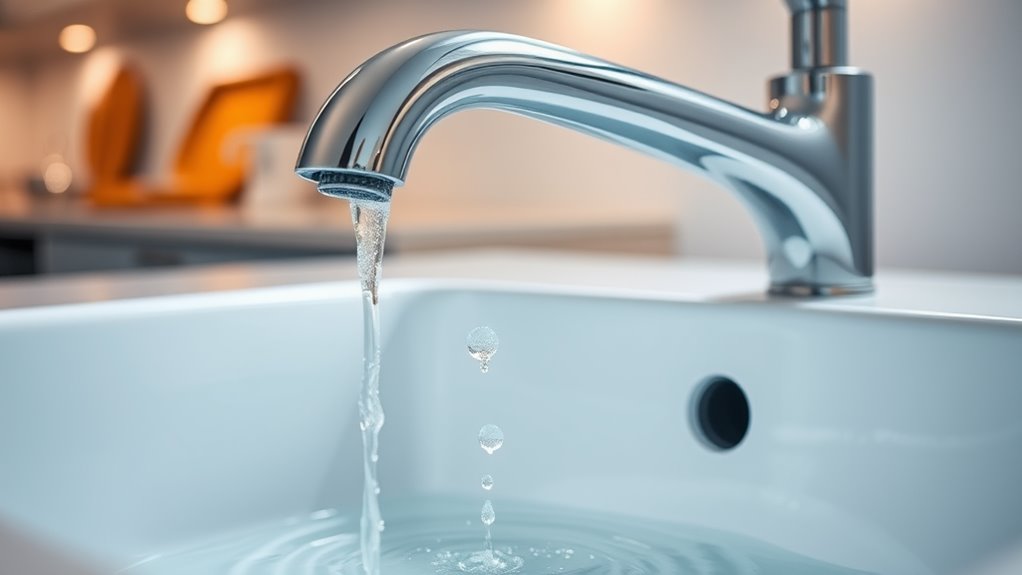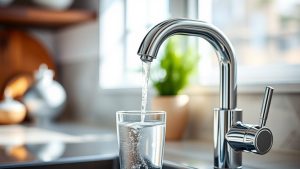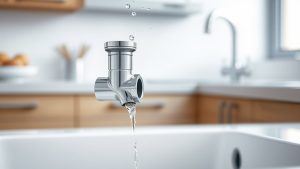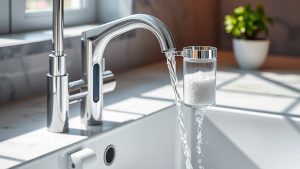What Is a Reverse Osmosis Faucet and How Does It Work?
Discover the benefits of a reverse osmosis faucet and how it delivers pure water—uncover the secrets behind its efficient operation now!

A reverse osmosis faucet lets you access purified water directly from your reverse osmosis system. It's designed to bypass unfiltered plumbing lines, ensuring you get high-quality drinking water free from up to 99% of contaminants. The faucet mounts into your countertop and features an operational lever for easy use. Depending on your needs, you can choose between air-gap and non-air gap models. Understanding these options can help you select the right faucet for your kitchen setup.
If you're looking for a reliable way to access clean drinking water, a Reverse Osmosis (RO) faucet could be the perfect solution. This specialized faucet is designed to dispense filtered water from a reverse osmosis system, providing a direct line to purified water while bypassing unfiltered plumbing lines. By connecting to the filtered water source or storage tank, it guarantees that you have easy access to safe drinking water at all times. Additionally, reverse osmosis systems efficiently remove up to 99% of contaminants, ensuring high-quality drinking water.
The primary purpose of an RO faucet is to deliver clean drinking water by utilizing the advanced filtration capabilities of an RO system. These faucets are often included with the RO systems they complement, assuring compatibility and ease of installation. When choosing an RO faucet, you'll find a variety of designs to match your kitchen decor or specific functional needs, from sleek modern finishes to classic styles.
An RO faucet delivers clean drinking water effortlessly, combining advanced filtration with stylish designs for any kitchen decor.
Installing a reverse osmosis faucet involves placing its base into a hole in your countertop, typically situated next to your regular sink faucet. The operational lever or dial allows you to turn the faucet on and off with ease. Water is dispensed through a narrow arched tube designed for ideal flow. Most RO faucets are constructed from metal, offering both durability and aesthetic appeal, guaranteeing they stand up to regular use while enhancing the overall look of your kitchen.
There are two main types of RO faucets: non-air gap and air-gap faucets. Non-air gap faucets work well with most standard RO systems but lack backflow protection. In contrast, air-gap faucets provide an added layer of safety against back-siphoning through an air gap between the dispenser and the outlet. Both types are compatible with reverse osmosis water filtration systems, so you can choose based on your needs.
One of the most significant benefits of using a reverse osmosis faucet is the easy access it provides to filtered drinking water. This convenience translates into reduced contamination levels compared to unfiltered tap water. The filtration process improves the taste and odor of your water, removing impurities that can affect quality. By reducing lower levels of health risks associated with waterborne contaminants, an RO faucet contributes to your overall health and well-being.
When considering a reverse osmosis faucet, you'll want to think about the installation site. The faucet typically mounts next to your regular sink and requires a hole in the countertop for proper integration. It's crucial to verify compatibility with your existing RO filtration system, checking that it can handle the necessary water pressure and flow rate. Some designs emphasize ergonomic handling, making it easy to use daily.
Conclusion
In conclusion, a reverse osmosis faucet provides you with purified water by utilizing a multi-stage filtration process. This guarantees that contaminants are effectively removed, offering you cleaner and safer drinking water. For instance, imagine a family in a city with high lead levels in their tap water; by installing a reverse osmosis system, they can confidently enjoy fresh, lead-free water straight from their faucet, enhancing their overall health and peace of mind.








